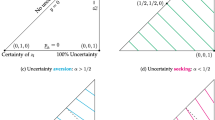Summary
Novick and Lindley (1978, 1979) have dealt with the use of utility functions for applications in education and have advocated the use of the standard gamble (von Neumann and Morgenstern, 1953) elicitation procedure with the addition of coherence checking using overspecification and a least squares fit. In this procedure utilities are inferred from probability judgements offered by the assessor. This paper describes local and regional coherence procedures which seek utility coherence in successive restricted domains of the parameter space as preludes to overall coherence checking. These procedures and some others are viewed as possible ways of avoiding anchoring and certainty effect biases found in earlier fixed probability methods, and presumably present in current fixed state procedures.
Similar content being viewed by others
References
Degroot, M.H. (1970).Optimal statistica decisions. New York: McGraw Hill.
— (1975).Probability and statistics. Reading, Mass: Addison-Wesley.
Fischhoff, B., Slovic, P., & Lichtenstein, S. (1977). Fault trees: Sensitivity of estimated failure probabilities to problem representation.Tech. Rep. PTR—1042-77-8, University of Iowa.
— (1980). Knowing what you want: Measuring labile values. Appearing inCognitive Processes in Choice and Decision Behavior. (T. Wallston, ed.) Hillsdale, New Jersey: Laurence Erlbaum Associates, (In press).
Gross, A.L., &Su, W.H. (1975). Defining a “fair” or “unbiased” selection model: A question of utilities.J. Appl. Psychol.60, 345–351.
Hogarth, R.M. (1975). Cognitive processes and the assessment of subjective probability distributions.J. Amer. Statist. Assoc.20, 271–289.
Kahneman, D., &Tversky, A. (1978). Prospect theory: An analysis of decision under risk.Econometrica.47, 263–291.
— (1972). Subjective probability: A judgment of representativeness.Cognitive Psychology 3, 430–454.
Keeney, R.L., &Raiffa, H. (1976).Decisions with multiple objectives: Preferences and value tradeoffs. New York: Wiley.
Kneppreth, N.P., Gustafson, D.H., Leifer, R.P., &Johnson, E.M. (1974). Techniques for the assessment of worth.U.S. Army research institute for the behavioral and social sciences.Tech. Rep.254, 40–53.
Lehmann, E.L. (1959).Testing Statistical Hypothesis. New York: Wiley.
Mosteller, F., &Nogee, P. (1951). An experimental measurement of utility.Political Economy,59, 371–404.
Novick, M.R. (1973). High School attainment: an example of a computer-assisted Bayesian approach to data analysis.Internat. Statist. Rev.41, 269–271.
— (1975). A cource in Bayesian Statistics.Amer. Statist. 29, 94–97.
Novick, M.R., &Isaacs, G.L. (1978). Manual for the computer-assisted data analysis (CADA) Monitor, Iowa City: The University of Iowa.
Novick, M.R., &Isaacs, G.L., Hamer, R., Chen, J., Chuang, D., Woodworth, G., Molenaar, I., Lewis, C., &Libby, D. (1980).Manual for The Computer-assisted data analysis monitor, Iowa City: The University of Iowa
Novick, M.R., &Jackson, P.H. (1974).Statistical methods for educational and psychological research. New York: McGraw Hill.
Novick, M.R., &Lindley, D.V. (1979). Fixed state assessment of utility functions.J. Amer. Statist. Assoc.74, 306–311.
Novick, M.R., & Lindley, D.V. (1978). The use of more realistic utility functions in educational applications.J. Educational Measurement, 181–192.
Novick, M.R., &Petersen, N.S. (1976). Towards equalizing educational and employment opportunity.J. Educational Measurement,13, 77–88.
Petersen, N.S. (1976). An expected utility model for “optimal” selection.J. Educational Statistics1, 333–358.
Petersen, N.S., &Novick, M.R. (1976). An evaluation of some models for culture-fair selection.J. Educational Measurement,13, 3–31.
Raiffa, H., &Schlaifer, R. (1961).Applied statistical decision theory, Boston: Harvard University.
Schlaifer, R. (1959).Probability and statistics for business decisions: An introduction to managerial economics under uncertainty, New York: McGraw Hill.
Slovic, P. (1975). Choice between equally valued alternatives.Experimental Psychol.3, 280–287.
— (1972). From Shakespeare, to Simon: Speculation-and some evidence-about man’s ability to process information.Oregon Research Institute Research Bulletin,12, 1–29.
Slovic, P., Fishchoff, B., &Lichtenstein S. (1977). Behavioral decision theory.Annual Rev. Psychol.,28, 1–39.
Spetzler, C.S., &Stael von Holstein, C.A.S. (1975). Probability encoding decision analysis.Management Science,22, 340–358.
Suppes, P., &Walsh, K. (1959). A non-linear model for the experimental measurement of utility.Behavioral Science,4, 204–211.
Swalm, R.O. (1966). Utility theory—insights into risk taking.Harvard Business Rev.44, 123–136
Tversky, A. (1977). On the elicitation of preferences: Descriptive and prescriptive considerations. InConflicting objectives in decisions, (D.E. Bell, R.L. Keeney and H. Raiffa eds.) 209–222. New York: Wiley.
Tversky, A. &Kahneman, D. (1974). Judgment under uncertainty: Heuristics and biasesScience,185, 1124–1131.
Van der Linden, W.J. &Mellenbergh, G.J. (1977). Optimal cutting scores using a linear loss function.Appl. Psychol. Measurement,1, 593–599.
Vleck, C.A.J. (1973). Coherence of human judgment in a limited probabilistic environment.Organizational Behavior and Human Performance,9, 460–481.
Von Neumann, J. &Morgenstern, O. (1953).Theory of games and economic behavior. Princeton: University Press.
References in the Discussion
Aitchison, J. andDunsmore, I.R. (1975)Statistical Prediction Analysis. Cambridge: University Press.
Berkson, J. (1938) Some difficulties of interpretation encountered in the application of the chi-squared test.J. Amer. Statist. Assoc.33, 526–42.
DeGroot, M.H. (1970)Optimal Statistical Decisions, Reading, Mass: Addision-Wesley.
Kadane, J.B. andDickey, J.M. (1979) Bayesian decision theory and the simplification of models.Evaluation of Economic Models. (J. Kmenta and J. Ramsey, Eds.) New York: Academic Press.
Kadane, J.B., Dickey, J.M., Winkler, R.L., Smith, andPeters, S.C., 1979.Tech. Rep.150, Carnegie-Mellon.
Kelly, G.A. (1955)The Psychology of Personal Constructs. New York: Wiley.
O’Hagan, A (1979) On outlier rejection phenomena in Bayes inference.J. Roy. Statist. Soc. B.41. 358–367.
O’Hagan, A. andLeonard, T. (1976) Bayes estimation subject to uncertainty about parameter constraints.Biometrika63, 201–203.
Popper, K. (1972)Objective Knowledge: An Evolutionary Approach. Oxford: Clarendon Press.
Shafer, G. (1976)A Mathematical Theory of Evidence. Princeton: University Press.
Spetzler, C.S. (1968) I.E.E.E. Trans. Systems, Science Cybernetics. SSC-4, 297–300.
STROUD, T.W.F. (1980) Empirical Bayes versions of Stein-type estimators.Tech. Rep. Stanford University.
Author information
Authors and Affiliations
Rights and permissions
About this article
Cite this article
Novick, M.R., Dekeyrel, D.F. & Chuang, D.T. Local and regional coherence utility assessment procedures. Trabajos de Estadistica Y de Investigacion Operativa 31, 557–581 (1980). https://doi.org/10.1007/BF02888368
Issue Date:
DOI: https://doi.org/10.1007/BF02888368




